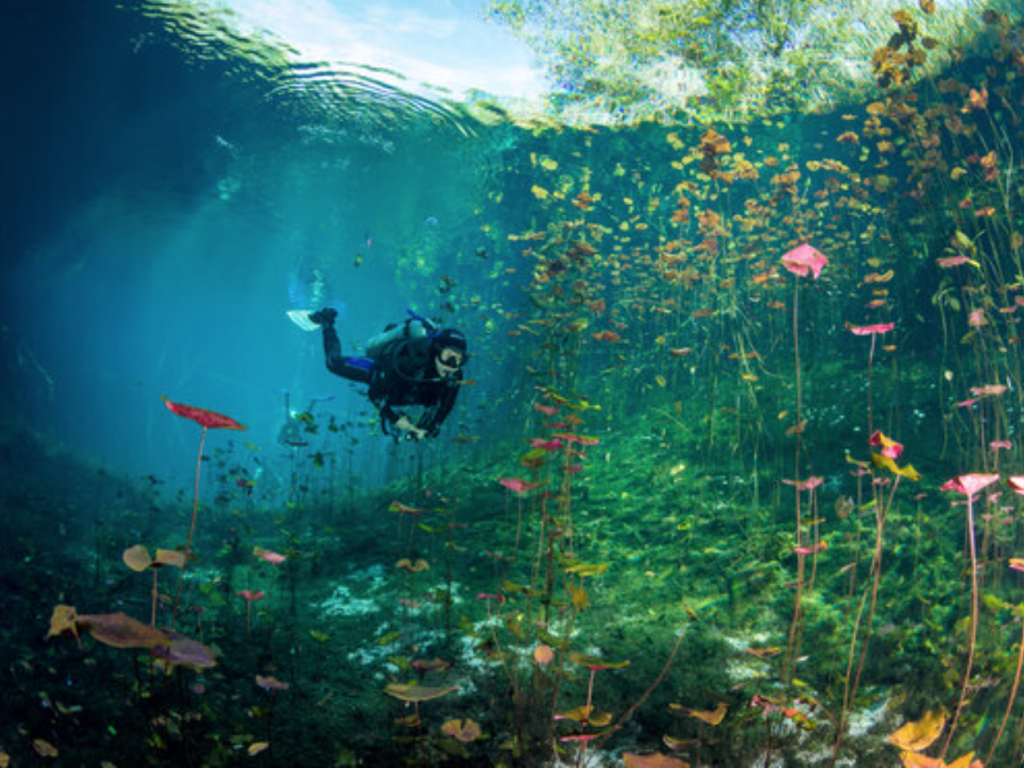HIGHLIGHTS





Get Your Bearings
Just south of Cancún sits Mexico’s Riviera Maya, a coastline full of tempting travel offerings.
Discover the Mesoamerican Reef (the largest barrier reef system in the Atlantic Ocean), Mayan ruins touching powder-soft sand in Tulum, a buzzing nightlife scene in Playa del Carmen, and sea turtles floating majestically in the waters of Akumal.
Cozumel, a glistening tropical paradise off the coast of Mexico’s Yucatan Peninsula, was once a bustling Mayan metropolis. With two very different sides to this beautiful island, one can access modern amenities around its main town of San Miguel, and yet still find numerous places on the far side of the island to get away from it all.
Ancient Wonders
Experience the Cenotes
A “cenote” (pronounced say-NO-tay) is a natural sinkhole created where a cave ceiling has collapsed, creating a window to a spectacular world. While some cenotes are vertical, water-filled shafts, others are caves that contain pools and underwater passageways in their interior.
Cenotes were the only source of water in the jungle for the Mayan civilization and are considered sacred by the Mayan people. The Mayan considered cenotes to be an entrance to their “underworld” or “Xibalba” where their gods live and their spirits reside after death.
One of the most famous and popular cenotes in Mexico, Gran Cenote, is actually a string of cenotes connected by walking paths. The primary cenote is a winding river-like open-air space that meanders around and is delightful for swimming and snorkeling. There are several cave sections as well for exploring, and the surrounding rock formations and jungle add to the beauty of the area.
Cenote Ponderosa (also called Jardin del Eden) is a sprawling open-air cenote of vibrant turquoise water surrounded by a verdant jungle and rocky outcroppings. With shallow and deep areas, the large cenote is popular for swimming, snorkeling, and especially scuba diving.
One of the most Instagrammed cenotes in Mexico, Cenote Suytun has a stone path to a circular platform in the middle of its large round pool. Near Valladolid, Suytun is a popular stop on tours and for a good reason. This giant cave cenote is one of the more picturesque of the lot. With towering stalactites, the cave walls are a creamy grey against the bright blue waters.
Mayan Ruins
With thousands of years of history in its rearview mirror, Mexico has some spectacular ancient ruins. The country has been home to dozens of indigenous tribes over the centuries, but few are as well known as the Maya. We are lucky to have the chance to visit these sites today and walk through true tactile history.
The Maya civilization was a Mesoamerican culture whose empire stretched from what is now southern Mexico through Guatemala, Belize, Honduras, and El Salvador. They built hundreds of impressive cities along an intricate network of roads, and ruled the region for hundreds of years. They were master mathematicians, astronomers, artists, and farmers.
The Mayan ruins at Cobá and Chichén Itzá make fantastic day expeditions, with the former housing a 120-step pyramid called Nohoch Mul, which offers awe-inspiring jungle views from the summit. The latter, Chichén Itzá, is further inland and is a UNESCO World Heritage Site and one of the New Seven Wonders of the World. Its most famous monument (El Castillo) has 365 steps for each day in the solar year.
Palenque, while not the largest Mayan city, it is one of the most important due to its sheer volume of inscriptions – a recorded history that has helped researchers truly understand the details of Mayan history and culture.
For more than 1,200 years, the city of Calakmul was an integral part of the Mayan world. Today, the site is located within the state of Campeche on more than 7,000 acres of World Heritage property within the Calakmul Biosphere Reserve.
Bonampak translates to “painted walls,” which could not be a more fitting title for this Mayan site in Chiapas. The main structure of the archaeological site is quite literally splashed with vibrant, colorful murals. In fact, these are the most well-preserved murals in the entire Mayan world.
While on Cozumel, a tour to the archaeological area of San Gervasio, is a must. This is one of the most studied Pre-Hispanic centers in the island of Cozumel. Settled in the place where the old Rancho San Gervasio used to be, this ceremonial complex also served as a worship center for the moon, love, gestation and medicine goddess: Ixchel.
Under the Waves
Diving the Cenotes
Many of the cenotes make for unforgettable and unique scuba diving opportunities.
Giant stride off the large platform at Gran Cenote and you enter the shady, cool world of the cenote, beneath the lily pads and into an ethereal underwater ballroom, which leads to endless passageways and chambers.
The aptly named Car Wash is where cabbies from Tulum used to wash their taxis. Beneath the surface of the pond, the water is either sapphire and emerald. A greenish slime covers branches and tree roots, creating an eerie, surreal landscape. Seeing this sight after reemerging from the stalactite-and stalagmite-riddled cavern is an experience unlike any other in Yucatan diving.
Dos Ojos, whose name in English means “two eyes,” is one of the most famous and oft-visited of Riviera Maya’s cenotes. It’s part of the Dos Ojos system, the deepest and among the longest of the Yucatan’s cave networks. Take a quick tour of the bat cave, then cool off by diving into the mid-70-degree water.
Diving the Reef
The Mesoamerican Reef, sometimes known as The Maya Reef, lies within the Caribbean Sea and touches the coasts of Mexico, Belize, Guatemala and Honduras. It contains the largest barrier reef in the Western Hemisphere, stretching nearly 700 miles from the northern tip of the Yucatan Peninsula down through the Honduran Bay Islands. Dazzling arrays of different types of coral form this underwater wilderness, and provide homes and food to hundreds of fish species, marine turtles, and sharks.
Barracuda Reef is really the stuff that myths are made from. With its crazy currents and magnificent marine life, which includes Hammerheads, black-tip reef sharks, eagle rays and of course barracuda, this is definitely a dive site not to be missed.
Santa Rosa Wall is one of the most popular deep dive sites. The wall begins at around 15 meters and extends deeper into the blue Caribbean abyss. Santa Rosa Wall has so much to offer divers including, enormous sponges, caves, swim-through tunnels, and overhangs of stony coral.
Colombia wall is over 30 meters high and is home to a stunning cave, tunnel and cavern systems. When diving at this site, you can expect to see giant coral pillars, some of which tower over 20 meters tall. Large barracuda are often seen here within the surrounding Caribbean waters, as well as large sea turtles, eagle rays, and beautiful reef fish.
Turtle Sanctuary at Akumal
Those looking for animal encounters with their swim should head to Akumal, a beach town located between Tulum and Playa del Carmen. Akumal is Maya for “place of the turtles,” which means there will be plenty of flippered friends waiting for you. Come face-to-face with them on a self-guided tour by swimming out from the dreamy white sand beach at Lol-Ha restaurant.
Colorful Culture
Enlightenment seekers may want to spend a little extra time in Tulum. It’s a destination filled with loveable contradictions. It’s spiritual yet hedonistic, boho yet affluent. It’s a place where yoga studios, healing pre-Hispanic temazcal sweat lodges, and electronic music-fueled nights coexist.
Dare to find adventure at night in Xplor Fuego, a park in Playa del Carmen that will ignite your adrenaline. Get on an amphibious vehicle and ride through the Mayan jungle, fly through the starry sky on Cancun zip-lines, explore the underground world of the Riviera Maya through stalactites rivers while swimming or rafting and splash in the waters of a cenote on a hammock.
After a week of sun and sea we can spend the last night of charter at any one of the amazing restaurants that dot the coastline. Parole has an incredible glowing atmosphere, while The Traveler’s Table offers contemporary fine-dining Mexican, and Macario’s reviews gush about the soft shell crab tacos and pork belly chicharrón.
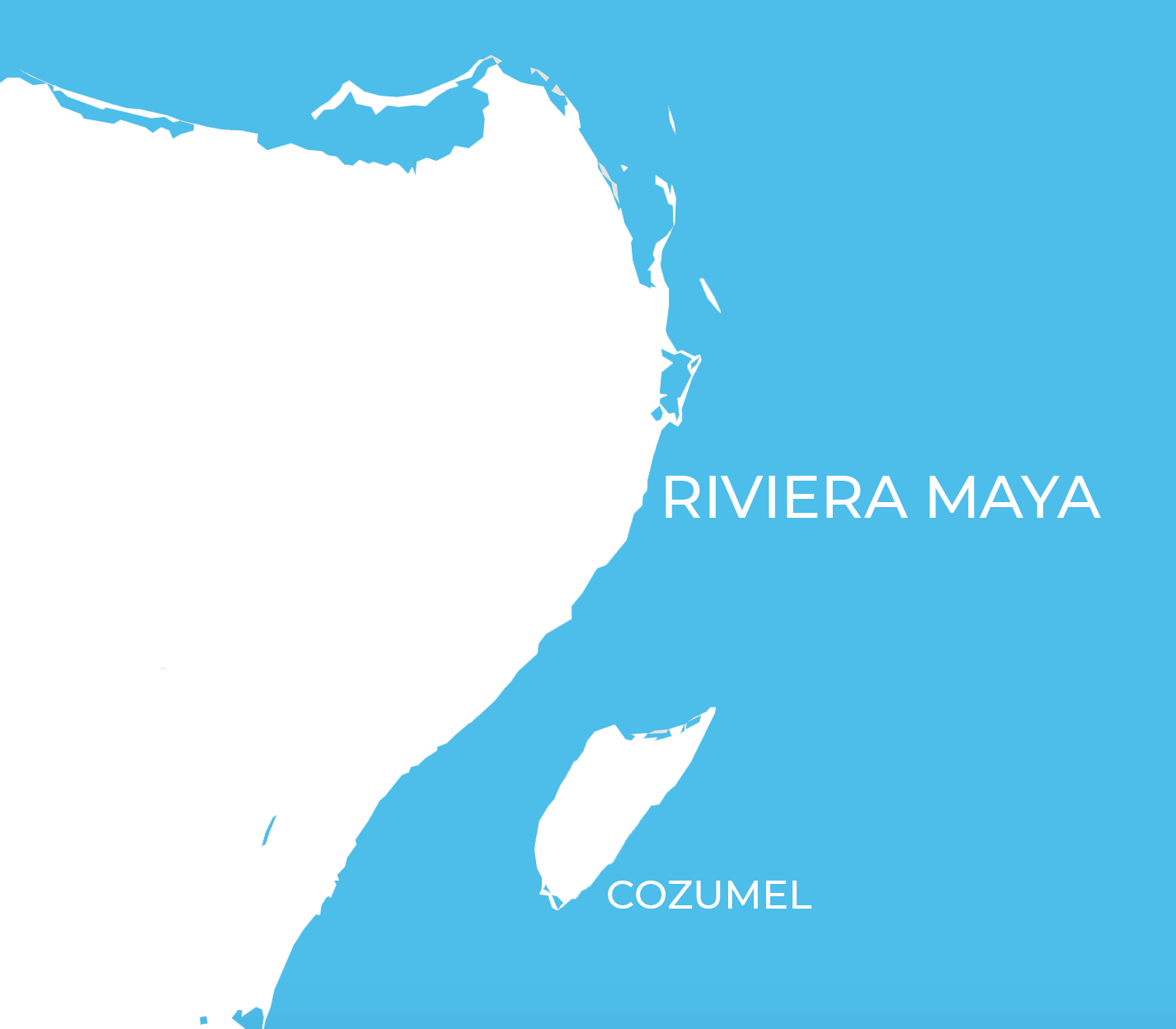
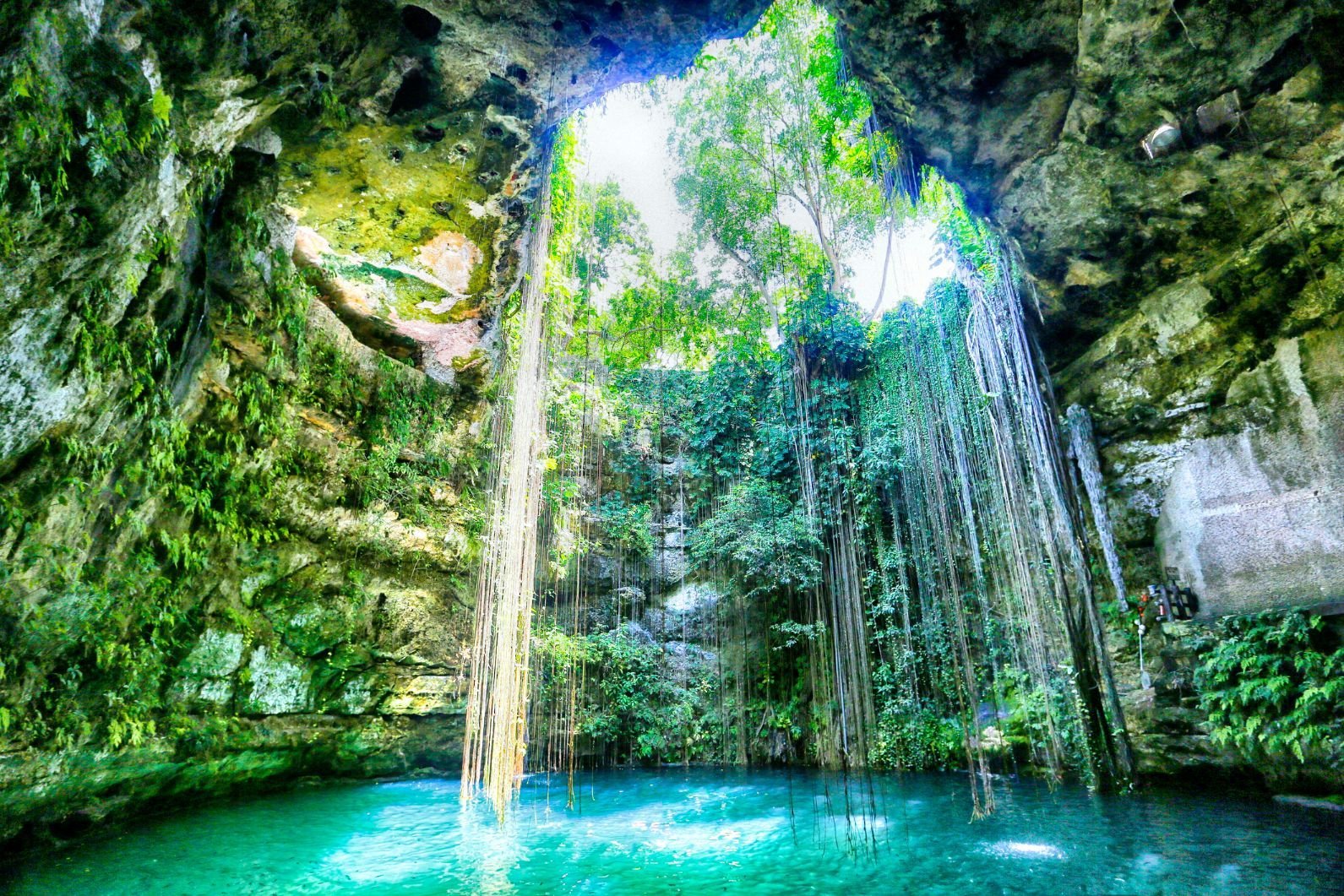
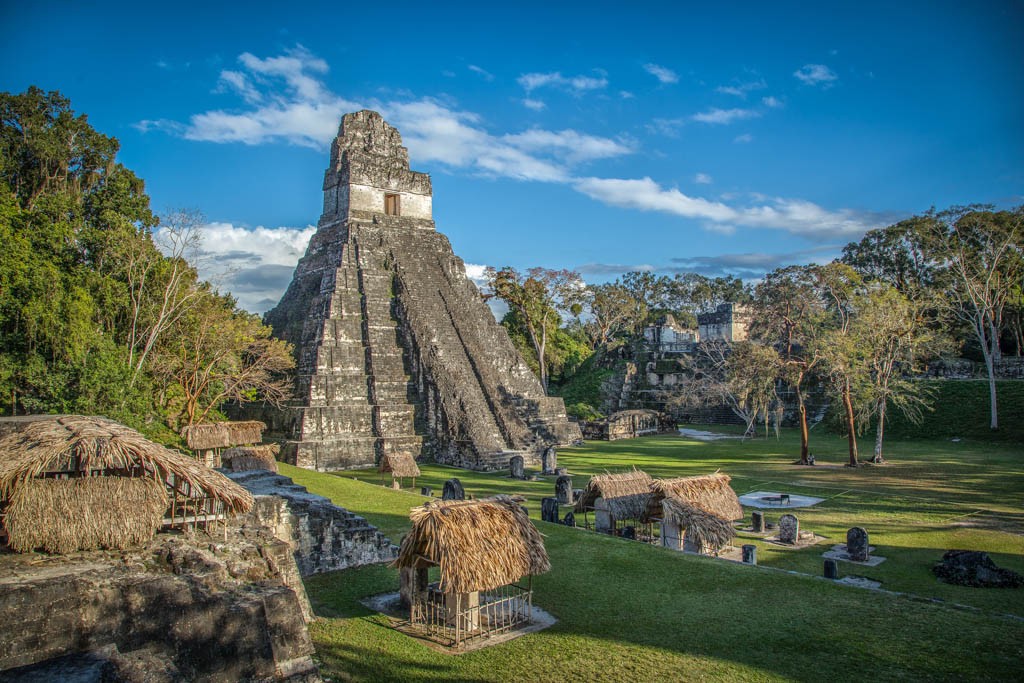
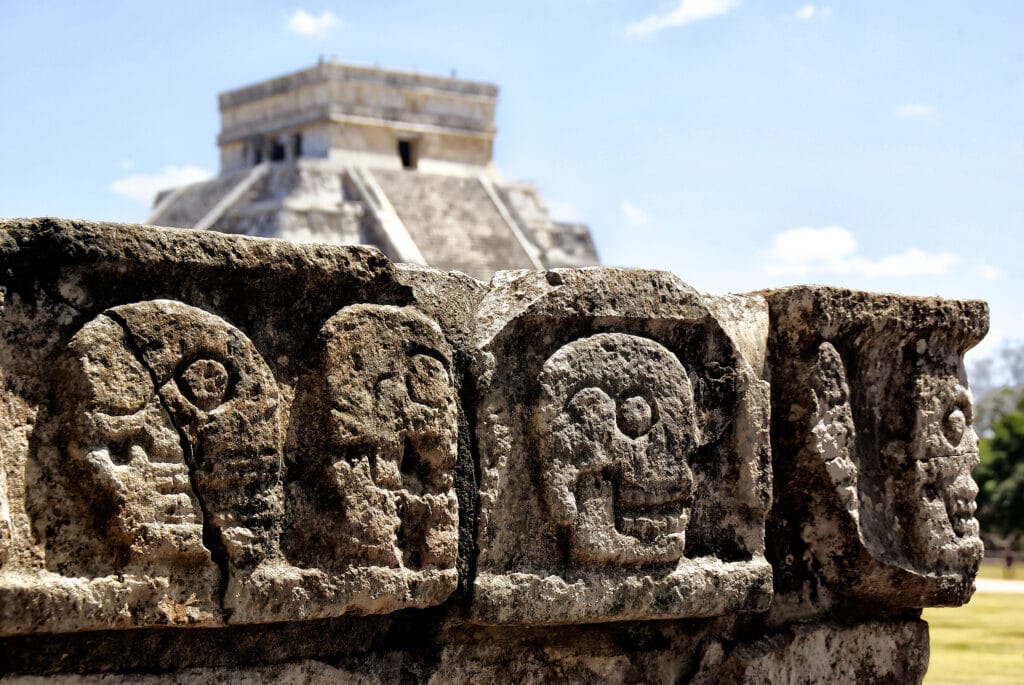
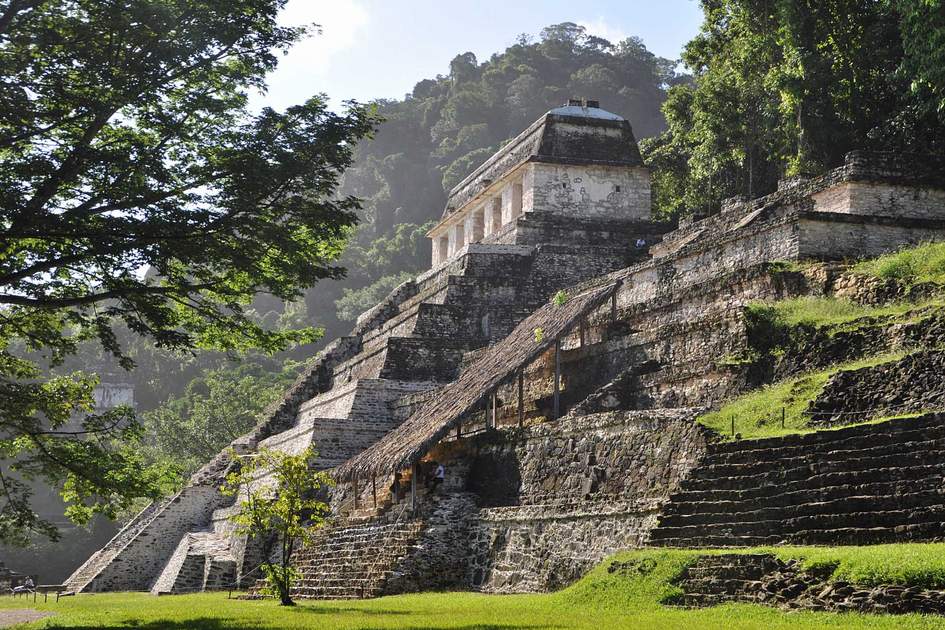
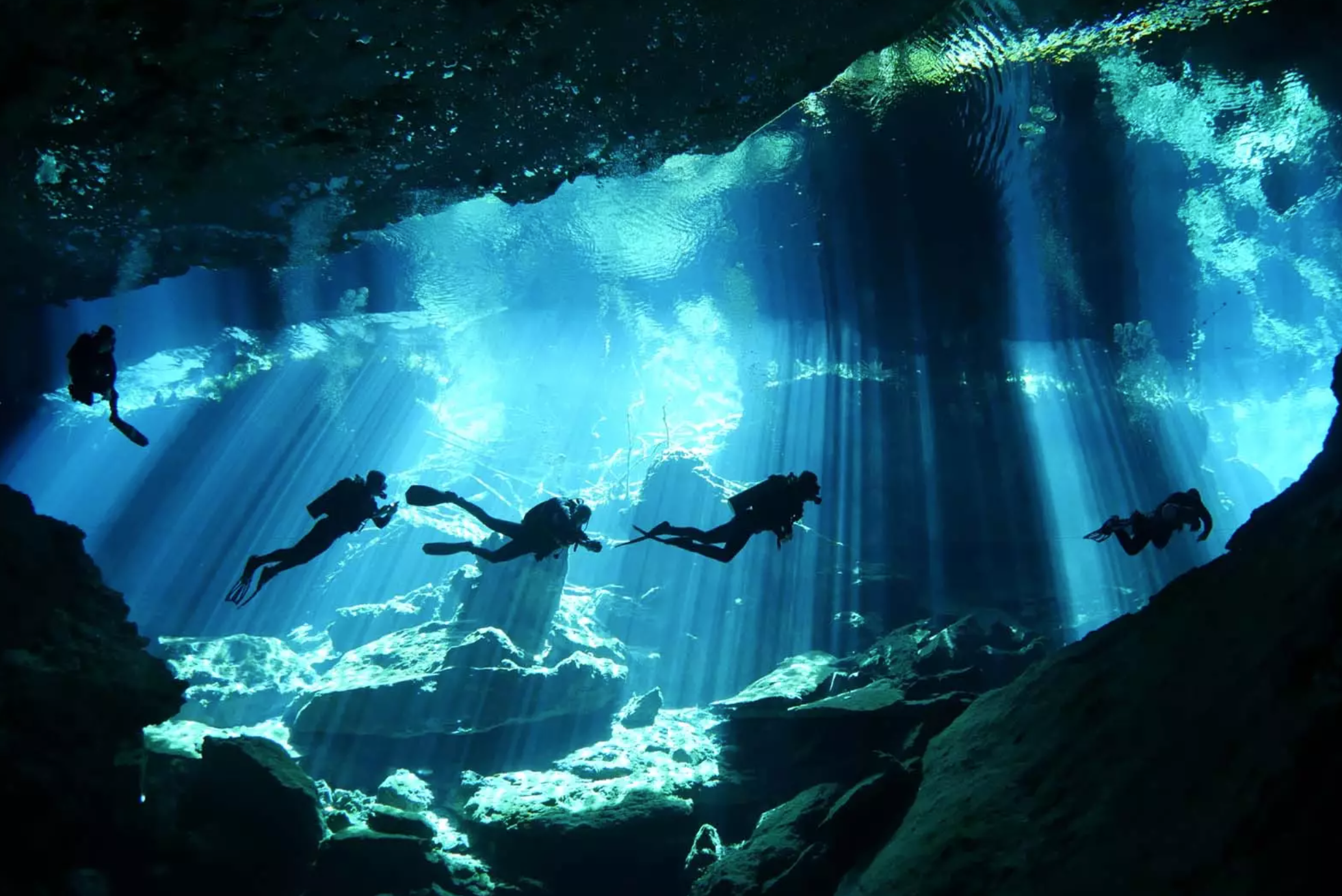
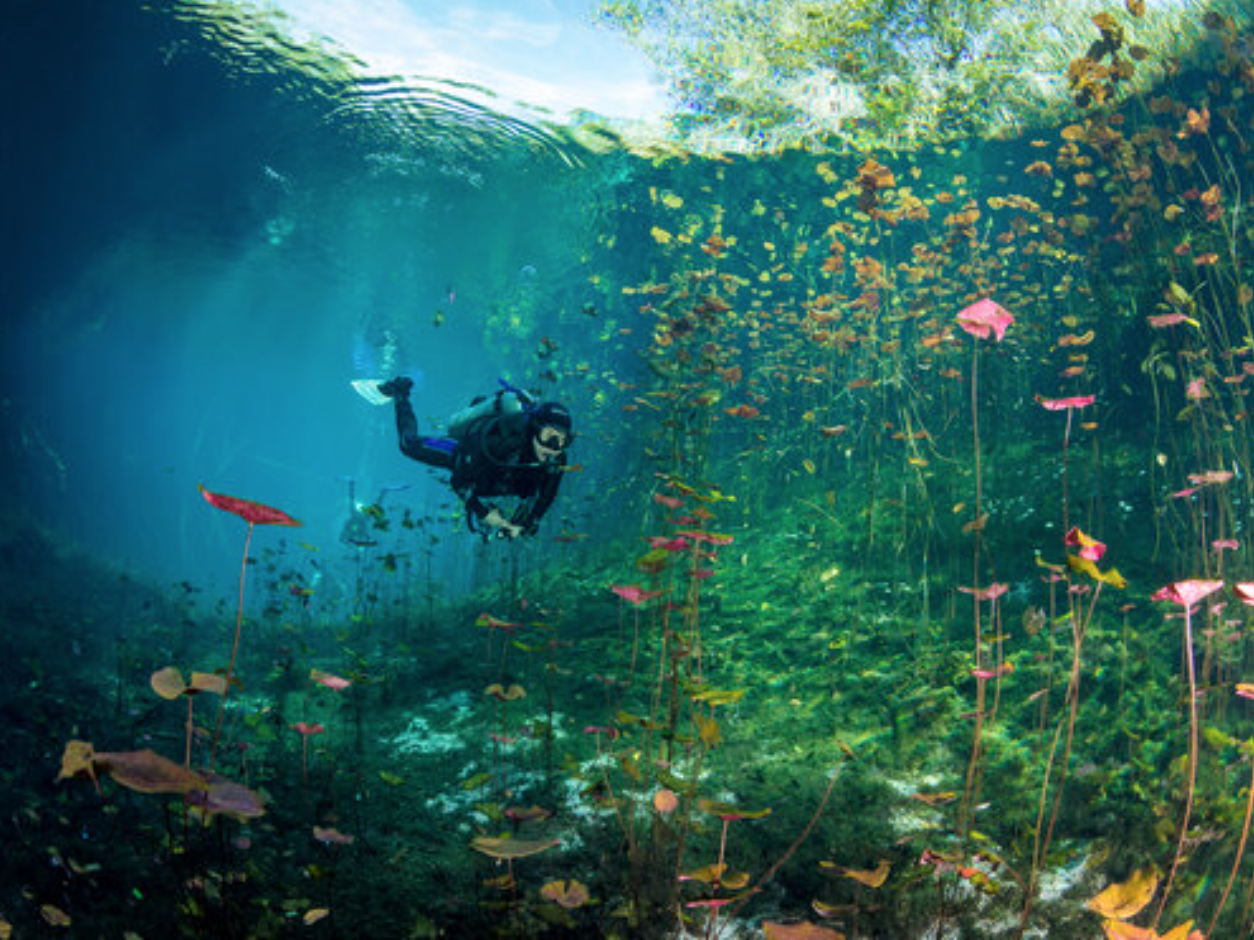
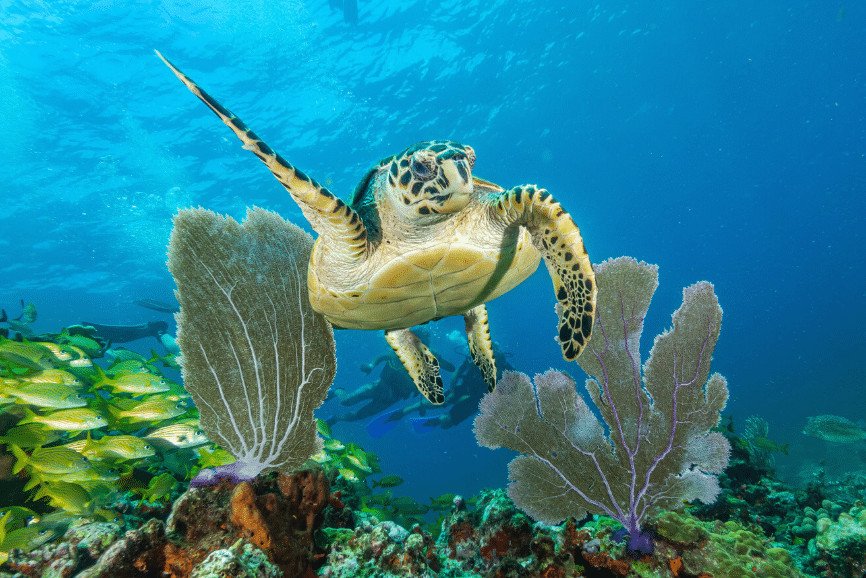
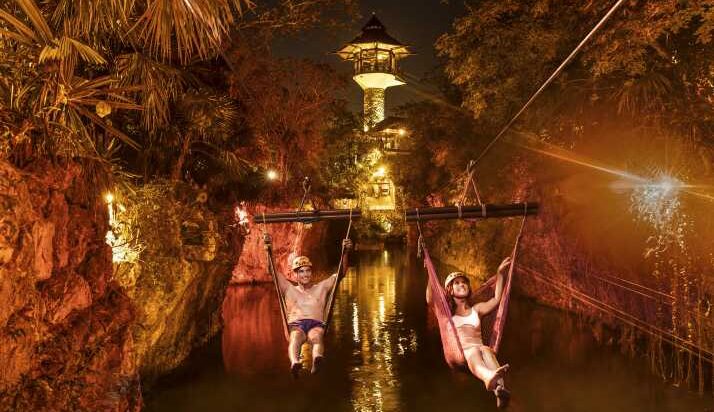

Get Your Bearings
Just south of Cancún sits Mexico’s Riviera Maya, a coastline full of tempting travel offerings.
Discover the Mesoamerican Reef (the largest barrier reef system in the Atlantic Ocean), Mayan ruins touching powder-soft sand in Tulum, a buzzing nightlife scene in Playa del Carmen, and sea turtles floating majestically in the waters of Akumal.
Cozumel, a glistening tropical paradise off the coast of Mexico’s Yucatan Peninsula, was once a bustling Mayan metropolis. With two very different sides to this beautiful island, one can access modern amenities around its main town of San Miguel, and yet still find numerous places on the far side of the island to get away from it all.

Ancient Wonders
Experience the Cenotes
A “cenote” (pronounced say-NO-tay) is a natural sinkhole created where a cave ceiling has collapsed, creating a window to a spectacular world. While some cenotes are vertical, water-filled shafts, others are caves that contain pools and underwater passageways in their interior.
Cenotes were the only source of water in the jungle for the Mayan civilization and are considered sacred by the Mayan people. The Mayan considered cenotes to be an entrance to their “underworld” or “Xibalba” where their gods live and their spirits reside after death.
One of the most famous and popular cenotes in Mexico, Gran Cenote, is actually a string of cenotes connected by walking paths. The primary cenote is a winding river-like open-air space that meanders around and is delightful for swimming and snorkeling. There are several cave sections as well for exploring, and the surrounding rock formations and jungle add to the beauty of the area.
Cenote Ponderosa (also called Jardin del Eden) is a sprawling open-air cenote of vibrant turquoise water surrounded by a verdant jungle and rocky outcroppings. With shallow and deep areas, the large cenote is popular for swimming, snorkeling, and especially scuba diving.
One of the most Instagrammed cenotes in Mexico, Cenote Suytun has a stone path to a circular platform in the middle of its large round pool. Near Valladolid, Suytun is a popular stop on tours and for a good reason. This giant cave cenote is one of the more picturesque of the lot. With towering stalactites, the cave walls are a creamy grey against the bright blue waters.
Mayan Ruins
With thousands of years of history in its rearview mirror, Mexico has some spectacular ancient ruins. The country has been home to dozens of indigenous tribes over the centuries, but few are as well known as the Maya. We are lucky to have the chance to visit these sites today and walk through true tactile history.
The Maya civilization was a Mesoamerican culture whose empire stretched from what is now southern Mexico through Guatemala, Belize, Honduras, and El Salvador. They built hundreds of impressive cities along an intricate network of roads, and ruled the region for hundreds of years. They were master mathematicians, astronomers, artists, and farmers.
The Mayan ruins at Cobá and Chichén Itzá make fantastic day expeditions, with the former housing a 120-step pyramid called Nohoch Mul, which offers awe-inspiring jungle views from the summit. The latter, Chichén Itzá, is further inland and is a UNESCO World Heritage Site and one of the New Seven Wonders of the World. Its most famous monument (El Castillo) has 365 steps for each day in the solar year.
Palenque, while not the largest Mayan city, it is one of the most important due to its sheer volume of inscriptions – a recorded history that has helped researchers truly understand the details of Mayan history and culture.
For more than 1,200 years, the city of Calakmul was an integral part of the Mayan world. Today, the site is located within the state of Campeche on more than 7,000 acres of World Heritage property within the Calakmul Biosphere Reserve.
Bonampak translates to “painted walls,” which could not be a more fitting title for this Mayan site in Chiapas. The main structure of the archaeological site is quite literally splashed with vibrant, colorful murals. In fact, these are the most well-preserved murals in the entire Mayan world.
While on Cozumel, a tour to the archaeological area of San Gervasio, is a must. This is one of the most studied Pre-Hispanic centers in the island of Cozumel. Settled in the place where the old Rancho San Gervasio used to be, this ceremonial complex also served as a worship center for the moon, love, gestation and medicine goddess: Ixchel.

Under the Waves
Diving the Cenotes
Many of the cenotes make for unforgettable and unique scuba diving opportunities.
Giant stride off the large platform at Gran Cenote and you enter the shady, cool world of the cenote, beneath the lily pads and into an ethereal underwater ballroom, which leads to endless passageways and chambers.
The aptly named Car Wash is where cabbies from Tulum used to wash their taxis. Beneath the surface of the pond, the water is either sapphire and emerald. A greenish slime covers branches and tree roots, creating an eerie, surreal landscape. Seeing this sight after reemerging from the stalactite-and stalagmite-riddled cavern is an experience unlike any other in Yucatan diving.
Dos Ojos, whose name in English means “two eyes,” is one of the most famous and oft-visited of Riviera Maya’s cenotes. It’s part of the Dos Ojos system, the deepest and among the longest of the Yucatan’s cave networks. Take a quick tour of the bat cave, then cool off by diving into the mid-70-degree water.
Diving the Reef
The Mesoamerican Reef, sometimes known as The Maya Reef, lies within the Caribbean Sea and touches the coasts of Mexico, Belize, Guatemala and Honduras. It contains the largest barrier reef in the Western Hemisphere, stretching nearly 700 miles from the northern tip of the Yucatan Peninsula down through the Honduran Bay Islands. Dazzling arrays of different types of coral form this underwater wilderness, and provide homes and food to hundreds of fish species, marine turtles, and sharks.
Barracuda Reef is really the stuff that myths are made from. With its crazy currents and magnificent marine life, which includes Hammerheads, black-tip reef sharks, eagle rays and of course barracuda, this is definitely a dive site not to be missed.
Santa Rosa Wall is one of the most popular deep dive sites. The wall begins at around 15 meters and extends deeper into the blue Caribbean abyss. Santa Rosa Wall has so much to offer divers including, enormous sponges, caves, swim-through tunnels, and overhangs of stony coral.
Colombia wall is over 30 meters high and is home to a stunning cave, tunnel and cavern systems. When diving at this site, you can expect to see giant coral pillars, some of which tower over 20 meters tall. Large barracuda are often seen here within the surrounding Caribbean waters, as well as large sea turtles, eagle rays, and beautiful reef fish.
Turtle Sanctuary at Akumal
Those looking for animal encounters with their swim should head to Akumal, a beach town located between Tulum and Playa del Carmen. Akumal is Maya for “place of the turtles,” which means there will be plenty of flippered friends waiting for you. Come face-to-face with them on a self-guided tour by swimming out from the dreamy white sand beach at Lol-Ha restaurant.
Colorful Culture
Enlightenment seekers may want to spend a little extra time in Tulum. It’s a destination filled with loveable contradictions. It’s spiritual yet hedonistic, boho yet affluent. It’s a place where yoga studios, healing pre-Hispanic temazcal sweat lodges, and electronic music-fueled nights coexist.
Dare to find adventure at night in Xplor Fuego, a park in Playa del Carmen that will ignite your adrenaline. Get on an amphibious vehicle and ride through the Mayan jungle, fly through the starry sky on Cancun zip-lines, explore the underground world of the Riviera Maya through stalactites rivers while swimming or rafting and splash in the waters of a cenote on a hammock.
After a week of sun and sea we can spend the last night of charter at any one of the amazing restaurants that dot the coastline. Parole has an incredible glowing atmosphere, while The Traveler’s Table offers contemporary fine-dining Mexican, and Macario’s reviews gush about the soft shell crab tacos and pork belly chicharrón.
SAMPLE ITINERARY
- 7-Nights Cancun & Isla Mujeres
- 7-Nights Cancun, Isla Mujeres & Cozumel
- 10-Nights Cancun, Isla Mujeres, Cozumel & Tulum

HIGHLIGHTS
- One or more days visiting Mayan Ruins and cenotes
- Dive cenotes
- Dive around Isla Mujeres
- Dinners ashore in lively Cancun
- Hikes around Isla Mujeres and the bird sanctuary

HIGHLIGHTS
- Dive the colorful sites on Cozumel
- Explore Mayan Ruins
- One full day sail
- Hikes around Isla Mujeres and the bird sanctuary
- Fishing at sea

HIGHLIGHTS
- Longer sails
- More advanced and varied diving opportunities
- Mayan ruins and cenotes
- Dining in foodie-centric Tulum
- Hikes around Isla Mujeres and the bird sanctuary
EXPLORE
Have a play around on this interactive map of our route to explore more places and activities available during our trip.
ACCOMMODATIONS
Accommodations include use of the following:
- 3 queen cabins, each with private ensuite bath with electric toilet, wash basin and separate shower stall. All cabins have ample storage, a panoramic window, air conditioning, two fans, US 110v outlets and dimmable recessed lighting.
- Social areas include an upper deck lounge with sectional couch and sunbed area with 360 degree view. Forward deck has spacious lounge area with adjustable reclining seating, trampoline and sunning areas. Aft deck offers lounge area plus alfresco dining. Salon offers lounge area with coffee table plus flat screen TV with many movies and USB capabilities.
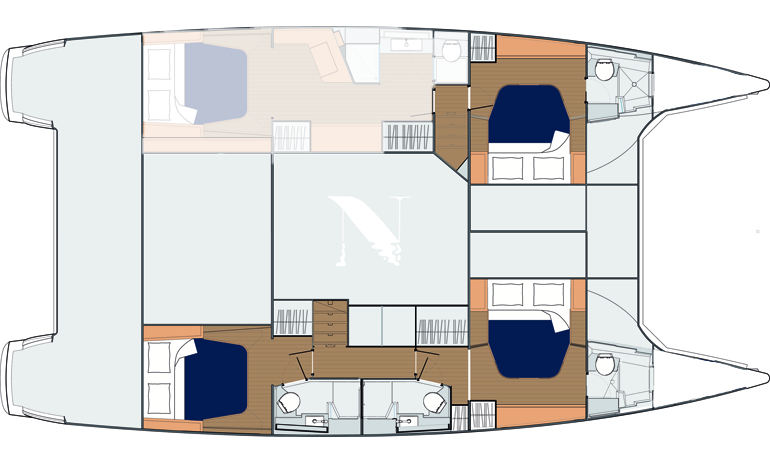
FYI
Flight info:
Cancun International Airport (CUN) or Cozumel International Airport (CZM)
Currency:
The currency in Mexico is the peso. USD is widely accepted.
Electricity: On board Neverland is US 110v
Communications: Neverland has on board wi-fi with high speed internet
We’ve got you covered: bath & beach towels, bedding, shower essentials, ScubaPro snorkel & dive gear, and dive lights
What to bring: soft-sided luggage, swimwear, sunscreen, beachwear, rain jacket, hat, sunglasses, music, books, camera, and personal snorkel/dive gear and wetsuit if you prefer
NEVERLAND CRUISES LLC
+1.305.912.SAIL
SAIL@NEVERLAND.CRUISES
SOCIAL
CONTACT
Send us a message below with thoughts or questions. Visit the contact page to inquire about a trip on Neverland.

